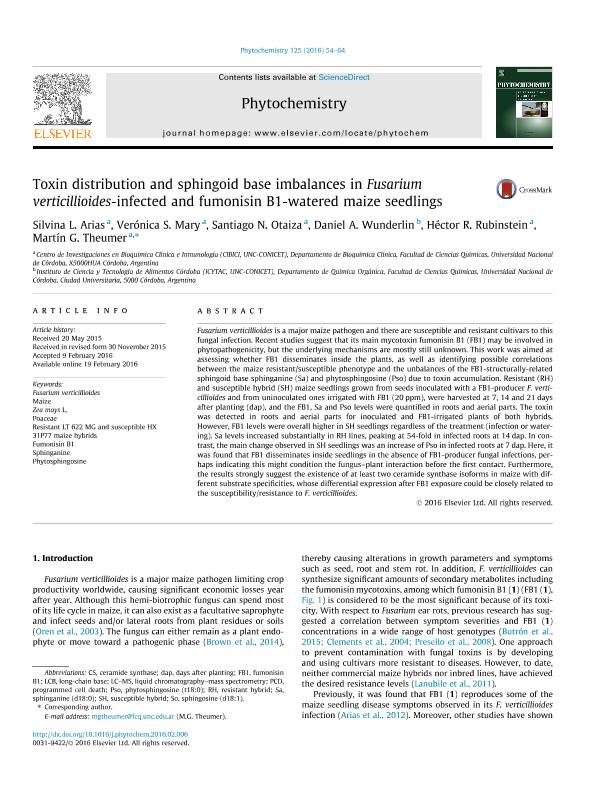Mostrar el registro sencillo del ítem
dc.contributor.author
Arias, Silvina Lorena

dc.contributor.author
Mary, Verónica Sofía

dc.contributor.author
Otaiza González, Santiago Nicolás

dc.contributor.author
Wunderlin, Daniel Alberto

dc.contributor.author
Rubinstein, Héctor Ramón

dc.contributor.author
Theumer, Martín Gustavo

dc.date.available
2018-05-30T18:32:31Z
dc.date.issued
2016-05
dc.identifier.citation
Arias, Silvina Lorena; Mary, Verónica Sofía; Otaiza González, Santiago Nicolás; Wunderlin, Daniel Alberto; Rubinstein, Héctor Ramón; et al.; Toxin distribution and sphingoid base imbalances in Fusarium verticillioides-infected and fumonisin B1-watered maize seedlings; Pergamon-Elsevier Science Ltd; Phytochemistry; 125; 5-2016; 54-64
dc.identifier.issn
0031-9422
dc.identifier.uri
http://hdl.handle.net/11336/46688
dc.description.abstract
Fusarium verticillioides is a major maize pathogen and there are susceptible and resistant cultivars to this fungal infection. Recent studies suggest that its main mycotoxin fumonisin B1 (FB1) may be involved in phytopathogenicity, but the underlying mechanisms are mostly still unknown. This work was aimed at assessing whether FB1 disseminates inside the plants, as well as identifying possible correlations between the maize resistant/susceptible phenotype and the unbalances of the FB1-structurally-related sphingoid base sphinganine (Sa) and phytosphingosine (Pso) due to toxin accumulation. Resistant (RH) and susceptible hybrid (SH) maize seedlings grown from seeds inoculated with a FB1-producer F. verticillioides and from uninoculated ones irrigated with FB1 (20 ppm), were harvested at 7, 14 and 21 days after planting (dap), and the FB1, Sa and Pso levels were quantified in roots and aerial parts. The toxin was detected in roots and aerial parts for inoculated and FB1-irrigated plants of both hybrids.However, FB1 levels were overall higher in SH seedlings regardless of the treatment (infection or watering). Sa levels increased substantially in RH lines, peaking at 54-fold in infected roots at 14 dap. In contrast, the main change observed in SH seedlings was an increase of Pso in infected roots at 7 dap. Here, it was found that FB1 disseminates inside seedlings in the absence of FB1-producer fungal infections, perhaps indicating this might condition the fungus?plant interaction before the first contact. Furthermore, the results strongly suggest the existence of at least two ceramide synthase isoforms in maize with different substrate specificities, whose differential expression after FB1 exposure could be closely related to the susceptibility/resistance to F. verticillioides.
dc.format
application/pdf
dc.language.iso
eng
dc.publisher
Pergamon-Elsevier Science Ltd

dc.rights
info:eu-repo/semantics/openAccess
dc.rights.uri
https://creativecommons.org/licenses/by-nc-sa/2.5/ar/
dc.subject
Fusarium Verticillioides
dc.subject
Fumonisin B1
dc.subject
Maize
dc.subject
Sphinganine
dc.subject
Phytosphingosine
dc.subject.classification
Otras Ciencias Biológicas

dc.subject.classification
Ciencias Biológicas

dc.subject.classification
CIENCIAS NATURALES Y EXACTAS

dc.title
Toxin distribution and sphingoid base imbalances in Fusarium verticillioides-infected and fumonisin B1-watered maize seedlings
dc.type
info:eu-repo/semantics/article
dc.type
info:ar-repo/semantics/artículo
dc.type
info:eu-repo/semantics/publishedVersion
dc.date.updated
2018-05-22T21:49:34Z
dc.journal.volume
125
dc.journal.pagination
54-64
dc.journal.pais
Estados Unidos

dc.journal.ciudad
Oxford
dc.description.fil
Fil: Arias, Silvina Lorena. Consejo Nacional de Investigaciones Científicas y Técnicas. Centro Científico Tecnológico Córdoba. Centro de Investigaciones en Bioquímica Clínica e Inmunología; Argentina
dc.description.fil
Fil: Mary, Verónica Sofía. Consejo Nacional de Investigaciones Científicas y Técnicas. Centro Científico Tecnológico Córdoba. Centro de Investigaciones en Bioquímica Clínica e Inmunología; Argentina
dc.description.fil
Fil: Otaiza González, Santiago Nicolás. Consejo Nacional de Investigaciones Científicas y Técnicas. Centro Científico Tecnológico Córdoba. Centro de Investigaciones en Bioquímica Clínica e Inmunología; Argentina
dc.description.fil
Fil: Wunderlin, Daniel Alberto. Consejo Nacional de Investigaciones Científicas y Técnicas. Centro Científico Tecnológico Conicet - Córdoba. Instituto de Ciencia y Tecnología de Alimentos Córdoba. Universidad Nacional de Córdoba. Facultad de Ciencias Químicas. Instituto de Ciencia y Tecnología de Alimentos Córdoba; Argentina
dc.description.fil
Fil: Rubinstein, Héctor Ramón. Consejo Nacional de Investigaciones Científicas y Técnicas. Centro Científico Tecnológico Córdoba. Centro de Investigaciones en Bioquímica Clínica e Inmunología; Argentina
dc.description.fil
Fil: Theumer, Martín Gustavo. Consejo Nacional de Investigaciones Científicas y Técnicas. Centro Científico Tecnológico Córdoba. Centro de Investigaciones en Bioquímica Clínica e Inmunología; Argentina
dc.journal.title
Phytochemistry

dc.relation.alternativeid
info:eu-repo/semantics/altIdentifier/doi/https://dx.doi.org/10.1016/j.phytochem.2016.02.006
dc.relation.alternativeid
info:eu-repo/semantics/altIdentifier/url/https://www.sciencedirect.com/science/article/pii/S003194221630022X
Archivos asociados
